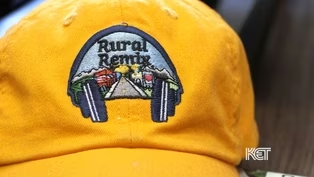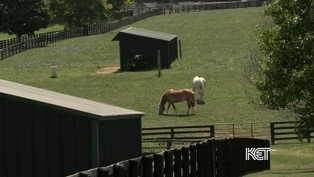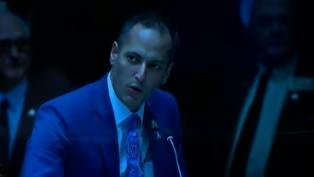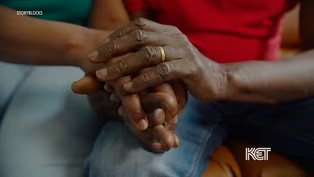
Tandy And Byrd
Clip: Season 3 Episode 54 | 4m 37sVideo has Closed Captions
A look at the legacy of two former slaves who had a major impact on Lexington.
Two former slaves, Henry Tandy and Albert Byrd, created a successful Black-owned construction company in Lexington during the Jim Crow Era. A recent presentation details their work and legacy.
Problems playing video? | Closed Captioning Feedback
Problems playing video? | Closed Captioning Feedback
Kentucky Edition is a local public television program presented by KET

Tandy And Byrd
Clip: Season 3 Episode 54 | 4m 37sVideo has Closed Captions
Two former slaves, Henry Tandy and Albert Byrd, created a successful Black-owned construction company in Lexington during the Jim Crow Era. A recent presentation details their work and legacy.
Problems playing video? | Closed Captioning Feedback
How to Watch Kentucky Edition
Kentucky Edition is available to stream on pbs.org and the free PBS App, available on iPhone, Apple TV, Android TV, Android smartphones, Amazon Fire TV, Amazon Fire Tablet, Roku, Samsung Smart TV, and Vizio.
Providing Support for PBS.org
Learn Moreabout PBS online sponsorshipTwo former slaves, Henry Tandy and Albert Byrd, created a successful black owned construction company in Lexington during the era of Jim Crow.
Back on July 19th, on the anniversary of Byrd's death.
African-American cemetery number two took a look back at their work.
And let's end Legacy in Lexington.
We sat down with Yvonne Giles and Randall Vaughan, who did the research and hosted the presentation.
Our built in diamond was Ribbon or the labor was provided by African Aryans just as during the period of enslavement.
After emancipation, African-Americans were still prominent in building our empire.
This was a thriving industry for African-Americans.
I had no idea.
It just shocked me.
The purpose of having this program is to introduce the audience and our community to African-Americans presence, even after enslavement and how much their work impacted our built environment.
African-American cemetery, two dozen, a series of seminars and workshops.
And I was approached by Miss Giles.
She wanted me to do this presentation on Henry Tandy and Albert Byrd.
Henry Tandy Nauvoo.
Byrd were amazing men.
They were not only artisans and craftsmen, but they were, you know, well respected businessmen at the turn of the century here in Lexington, Kentucky, and did some amazing things.
Many of the attendees, like many of the citizens of Lexington, would would are not aware of these amazing buildings that were built by the hands of these gentlemen and their workers.
And I think they would they were astounded at, you know, at the era in which these these works were created and the ability for them to, number one, employ up to 25 people, laborers, both black and white, at that hour or during the Jim Crow South.
You can dwell on the situations and the disadvantages that are presented to you, or you can be proactive and just move around ahead of them.
And I think truly, that's what Sandy and Burt did.
They had a job to do, and they were doing it at the top of their skill level.
And when you're at that position, you get less criticism and less backlash.
There was a physician, Dr. P.T.
Robbins, who actually profiled the company in the newspaper.
So we have that account of him talking about how successful they had been and it didn't.
One of the comments he made, it didn't matter their color that they had established the reputation.
And because of that, they were awarded a number of contracts that had been very successful.
And from what we know, they built from the time they organized their own company in 1893, they built 16 buildings.
Nine of them in central Kentucky are still standing.
We're on the side of the courthouse where it was said they laid over a million and a half bricks for the construction of the courthouse in 1898.
Other buildings that they constructed were on the campus of the University of Kentucky and eastern Kentucky University and a number of buildings in the downtown area of Lexington, Miller Hall at the University of Kentucky campus.
And there is a dormitory at Eastern Kentucky University, the old Lexington Dry Goods, the old the the Louis the college net mansion at the corner of Forest Avenue.
And Main Street.
Their legacy are the buildings that are standing.
They built their own monuments.
Although a date hasn't been set yet.
Giles and Vaughan are doing a bus tour in October to show locals where Tandy and Byrd's building still stand to honor their legacy and raise awareness about their work.
Video has Closed Captions
Clip: S3 Ep54 | 5m 32s | Podcast examines who is the rural voter. (5m 32s)
Video has Closed Captions
Clip: S3 Ep54 | 3m 32s | Mental health professionals that are looking to incorporate horses in their treatment options. (3m 32s)
State Lawmaker Removed From Committees
Video has Closed Captions
Clip: S3 Ep54 | 51s | State Rep. Daniel Grossberg has been removed from his House interim committees. (51s)
What Seth's Law Means For Kentucky
Video has Closed Captions
Clip: S3 Ep54 | 4m 13s | Seth's Law changes to the state court system. (4m 13s)
Providing Support for PBS.org
Learn Moreabout PBS online sponsorship
- News and Public Affairs

Top journalists deliver compelling original analysis of the hour's headlines.

- News and Public Affairs

FRONTLINE is investigative journalism that questions, explains and changes our world.












Support for PBS provided by:
Kentucky Edition is a local public television program presented by KET



